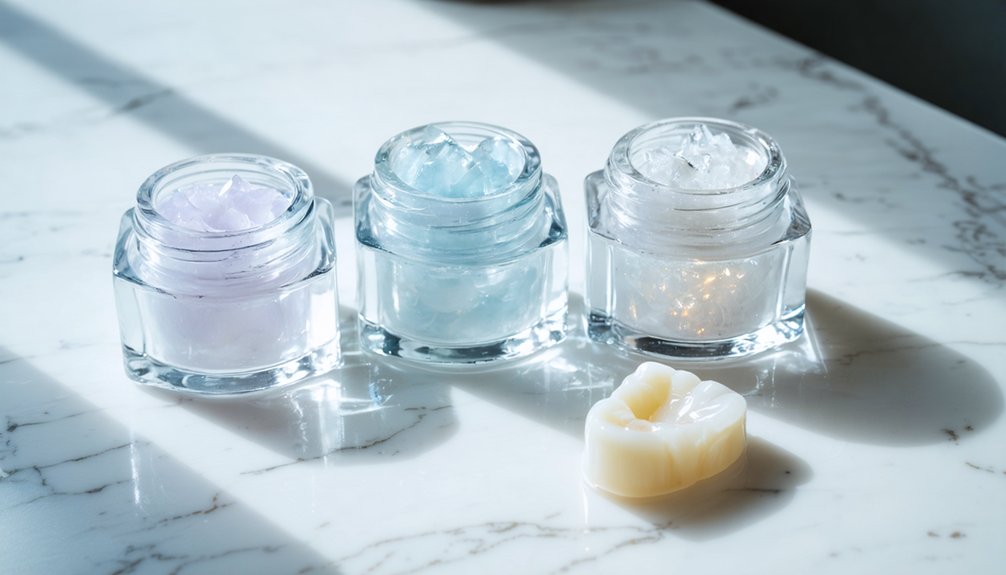For stubborn tooth stains, you’ll need professional-grade whitening gels containing 25-44% hydrogen peroxide or carbamide peroxide concentrations. These clinical-strength formulations penetrate deep into your enamel’s porous surface to break down both extrinsic and intrinsic stains through oxidation. Custom-fitted trays guarantee ideal contact while minimizing gum irritation. While over-the-counter products typically show minimal results, professional solutions can dramatically whiten teeth in just 1-2 sessions. Understanding the science behind these powerful formulations reveals why they’re so effective.
Key Takeaways
- Professional-grade whitening gels with 32-35% peroxide concentration provide the most dramatic results for removing stubborn stains.
- ADA-approved Opalescence PF offers effective take-home whitening treatment with custom-fitted trays for optimal gel contact.
- Clinical-strength formulations containing up to 44% hydrogen peroxide can eliminate deep intrinsic stains in one or two sessions.
- Extended treatment sessions of up to 2 hours may be necessary for particularly resistant stains when sensitivity permits.
- Regular maintenance with touch-up sessions every 6-12 months helps preserve whitening results and prevent stain recurrence.
Understanding Professional-Grade Whitening Gels
While over-the-counter whitening products have become widely available, professional-grade whitening gels offer superior formulations with higher concentrations of active ingredients.
These gel formulations primarily contain hydrogen peroxide or carbamide peroxide at concentrations of up to 45%, delivering more dramatic results than retail options.
Professional whitening protocols utilize these powerful agents through custom-fitted trays or in-office applications.
The peroxide compounds work by penetrating your enamel, breaking down stubborn stain molecules through oxidation.
Hydrogen peroxide acts quickly, while carbamide peroxide releases more gradually for sustained whitening.
Your dentist will determine the ideal concentration and application method based on your specific needs, carefully balancing efficacy with comfort.
The FDA regulates these professional whitening products as cosmetics to ensure public safety.
This supervised approach guarantees you’ll achieve excellent results while minimizing sensitivity and gum irritation.
Quality professional gels undergo rigorous testing to maintain consistent formulation standards that ensure safety and optimal performance.
The Science Behind Stubborn Tooth Stains
Because teeth stains develop through multiple mechanisms, understanding their scientific basis is essential for effective treatment.
Successful stain removal requires grasping how different discoloration mechanisms work and applying scientifically-proven treatment approaches.
You’ll encounter two primary types: extrinsic stains that form on your tooth’s surface, and intrinsic stains that develop within the tooth structure.
Chromogenic bacteria, tannins from beverages, and tobacco products create stubborn external discoloration, while trauma, medications, and developmental conditions cause internal staining. Since the enamel is made of crystalline calcium phosphate, its porous nature allows staining agents to penetrate the surface.
For ideal stain prevention, you’ll need to address both the chemical and structural factors at play. Regular dental cleanings can significantly reduce surface stains and prevent deeper discoloration from developing.
Your teeth’s enamel care becomes increasingly important as age-related porosity makes them more susceptible to staining.
The pellicle layer on teeth surfaces attracts pigments, while chromogens bind chemically to enamel proteins, creating particularly resistant discoloration that requires targeted professional intervention.
Top-Rated Clinical Strength Formulations
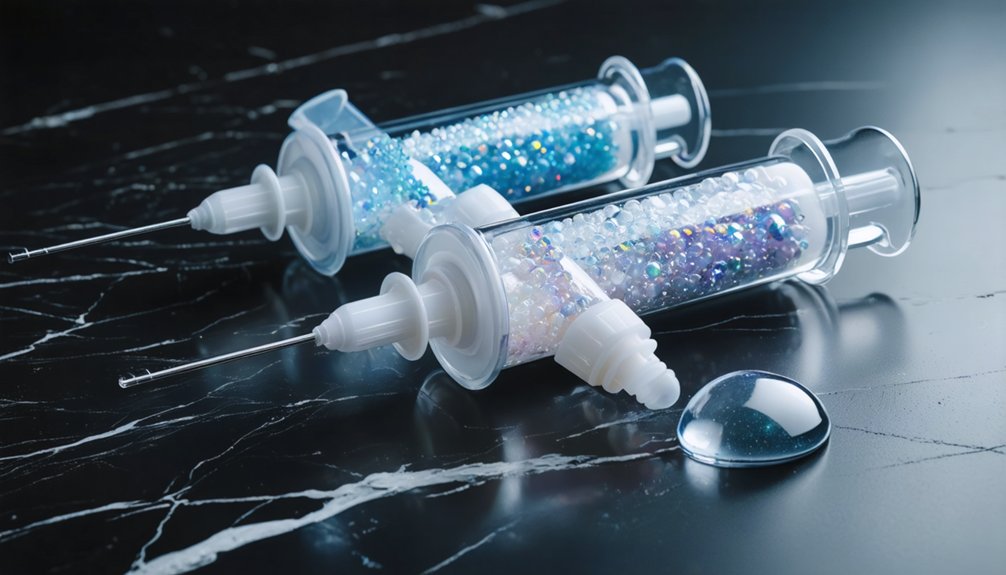
When you’re dealing with stubborn tooth stains, professional peroxide gels ranging from 16% to 44% concentration offer scientifically-proven whitening power.
You’ll find that higher concentrations like 32-35% deliver dramatic results within fewer sessions, though they require careful monitoring for sensitivity.
ADA-approved Opalescence PF leads the way in take-home whitening solutions with proven clinical results.
Consulting dental professionals is crucial since proper gum isolation prevents irritation when using stronger formulations.
Custom-fitted tray systems guarantee ideal contact between the gel and your teeth’s surface while minimizing soft tissue exposure, making them essential for achieving uniform, professional-grade results.
Professional Peroxide Gel Options
As dental professionals seek maximum whitening efficiency for their patients, professional-grade peroxide gels offer markedly higher concentrations than over-the-counter alternatives, typically ranging from 25% to 44% hydrogen peroxide.
These clinical-strength formulations deliver superior results for stubborn, deep stains in just one or two sessions. The use of LED or laser light during application helps accelerate the whitening process for optimal results. All gels are manufactured bi-weekly to ensure maximum freshness and effectiveness.
For ideal clinical efficacy, you’ll need to apply protective barriers and follow strict application guidelines.
These gels are available in various formats, including brush-on applications and tray-based systems, allowing you to customize whitening protocols based on patient needs.
While hydrogen peroxide gels require replacement every six months, carbamide peroxide options offer extended shelf life up to one year.
Many formulations now include specialized components like fluoride-free and vegan ingredients to accommodate diverse patient requirements.
Custom-Fitted Tray Systems
Custom-fitted tray systems represent the gold standard for professional-grade teeth whitening, combining precise fit with clinical-strength formulations.
These custom trays mold precisely to your teeth, guaranteeing even gel distribution and maximizing contact time with stubborn stains. The reusable design makes these trays a smart long-term investment for maintaining your bright smile.
Administered under dental office supervision, these whitening systems ensure optimal safety and personalized treatment planning for each patient.
You’ll benefit from higher-concentration peroxide formulations (10%-35%) compared to over-the-counter options, while the snug fit prevents gel leakage and enhances patient comfort.
The system allows for flexible treatment times that fit your schedule, typically requiring daily sessions of 30 minutes to several hours over a two-week period.
Professional supervision confirms you’re using appropriate concentrations for your sensitivity level and stain type.
Unlike ill-fitting store-bought trays, custom systems deliver consistent results by maintaining constant gel-to-tooth contact, effectively targeting both surface and deep discoloration.
Comparing At-Home Whitening Systems
While numerous at-home teeth whitening systems flood the market, they primarily fall into five main categories: LED kits, whitening strips, tray-based systems, natural alternatives, and peroxide-based solutions.
Despite common whitening myths, each system offers distinct advantages based on your specific needs and lifestyle.
LED kits combined with peroxide gels typically deliver the fastest results, showing improvement in as little as 3-10 days. Whitening strips provide comparable results to professional treatments when used correctly, while tray-based systems offer consistent contact with teeth for thorough whitening.
Consumer reviews consistently praise products like Crest 3DWhitestrips Sensitive + LED for minimizing discomfort while maintaining effectiveness.
For those seeking gentler options, natural alternatives like baking soda work gradually but with less risk of sensitivity.
Your choice should balance effectiveness, sensitivity concerns, and budget considerations.
Key Ingredients That Target Deep Discoloration
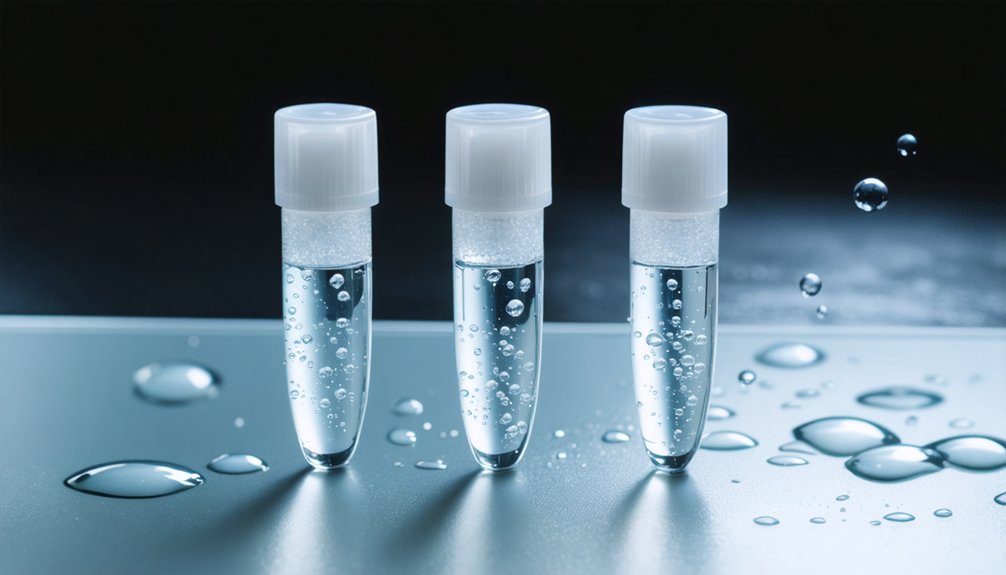
When targeting stubborn tooth discoloration, you’ll find that peroxide-based ingredients like hydrogen peroxide and carbamide peroxide create powerful oxygen radicals that break down deep stain molecules.
You can achieve superior results by selecting whitening gels that combine these active compounds with natural desensitizing agents like potassium nitrate, which helps minimize tooth sensitivity during treatment.
Professional-grade formulations containing higher peroxide concentrations (up to 38%) deliver more dramatic whitening effects compared to over-the-counter options, though they require careful application to protect your enamel’s integrity.
Understanding Peroxide-Based Actives
Peroxide-based whitening agents represent the cornerstone of modern tooth bleaching technology, with hydrogen peroxide (H₂O₂) and its precursor carbamide peroxide serving as the primary active ingredients.
The peroxide stability and whitening efficacy depend on formulation factors like pH levels and base materials. When you’re selecting a whitening treatment, you’ll find concentrations ranging from 3% to 35%, with higher levels typically reserved for professional applications.
- Hydrogen peroxide breaks down into water and oxygen, generating free radicals.
- Carbamide peroxide releases active H₂O₂ more slowly for sustained whitening.
- pH buffering to 9.5-10 optimizes formation of powerful perhydroxyl radicals.
- Base materials like carbopol control peroxide release timing.
- Deep penetration allows treatment of both surface and intrinsic stains.
These active ingredients work by oxidizing stain molecules, effectively breaking down discoloration compounds within both enamel and dentin layers.
Natural Whitening Compounds
Although synthetic whitening agents dominate the market, natural compounds offer alternative approaches for addressing tooth discoloration. You’ll find several natural alternatives that can target surface stains through different mechanisms.
Baking soda provides gentle abrasion to remove plaque, while hydrogen peroxide offers oxidizing properties similar to professional treatments but at lower concentrations. For deeper stains, activated charcoal‘s absorption properties may help lift discoloration molecules from your enamel.
When considering whitening effectiveness, fruit-based agents like strawberries contain malic acid that can break down stains when combined with baking soda. However, you’ll need to exercise caution with acidic ingredients like lemon juice or apple cider vinegar, as frequent use risks enamel erosion.
For ideal results, consider combining multiple natural approaches while maintaining consistent oral hygiene practices.
Desensitizing Ingredient Benefits
Successful whitening treatments must balance stain removal with tooth sensitivity management, which is why modern whitening gels incorporate specific desensitizing compounds.
When you’re selecting a whitening treatment, look for products containing proven desensitizing agents like potassium nitrate, strontium chloride, and fluoride. These ingredients work together to protect your teeth during the whitening process.
- Potassium nitrate (5%) calms nerve endings and blocks pain signals
- Strontium chloride (10%) provides immediate relief by sealing dentin tubules
- Tricalcium phosphate (19%) strengthens enamel during treatment
- Fluoride enhances protection against peroxide-induced sensitivity
- Combined desensitizing agents offer maximum sensitivity reduction while maintaining whitening effectiveness
These scientifically-proven ingredients guarantee your patients can achieve their desired results with minimal discomfort, making the whitening experience more comfortable and successful.
Treatment Duration and Expected Results
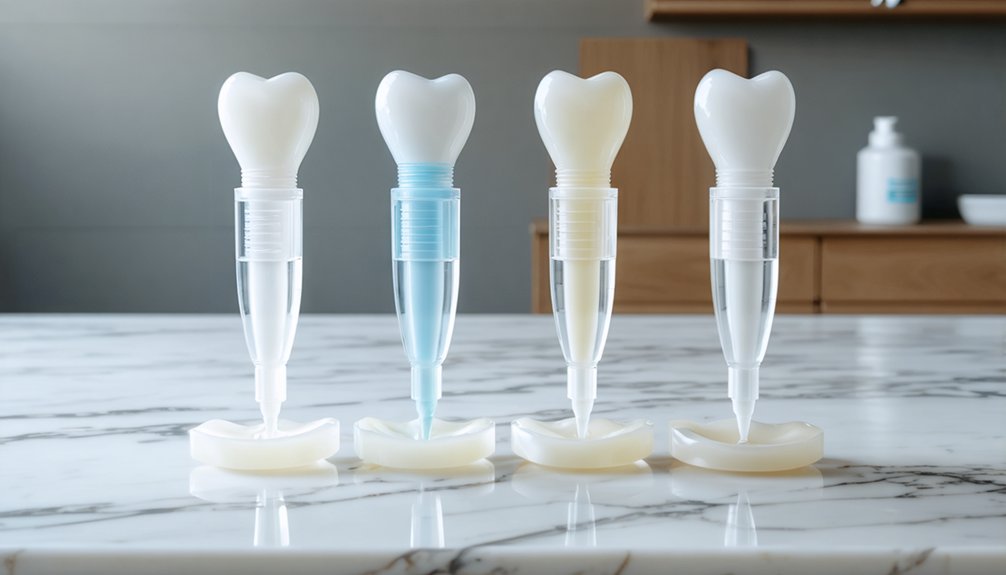
When starting a teeth whitening regimen, you’ll need to commit to a consistent treatment schedule spanning several weeks for ideal results.
Plan for daily sessions of 30-60 minutes initially, with the treatment timeline extending to 7-10 days for noticeable improvements. You’ll typically see initial brightening within the first week, with maximum expected outcomes appearing after 2-4 weeks of regular use.
For stubborn stains, you may need to extend sessions to 2 hours if sensitivity isn’t an issue. Higher peroxide concentrations will accelerate results but require shorter application times.
Remember that professional-grade products offer faster outcomes than over-the-counter options. Once you’ve achieved your desired shade, maintain results with touch-up sessions every 6-12 months, though lifestyle factors like coffee or wine consumption may necessitate more frequent treatments.
Safety Measures and Sensitivity Management
Safe teeth whitening requires careful attention to both product selection and application methods to minimize potential side effects.
Following proper safety protocols and sensitivity prevention measures will help guarantee ideal results while protecting your oral health. Your dentist can provide custom-fitted trays and professional-grade gels with desensitizing agents for maximum comfort and effectiveness.
- Choose ADA-approved whitening products to guarantee safety and efficacy
- Use custom-fitted trays to minimize gel contact with gums and soft tissues
- Start with lower peroxide concentrations to build tolerance gradually
- Apply desensitizing agents or fluoride treatments before whitening sessions
- Monitor sensitivity levels and adjust treatment frequency accordingly
If you experience acute sensitivity, pause your treatment temporarily and resume at a slower pace.
Remember that professional supervision offers the safest approach to achieving your desired whitening results while maintaining oral health.
Cost Analysis of Different Whitening Options
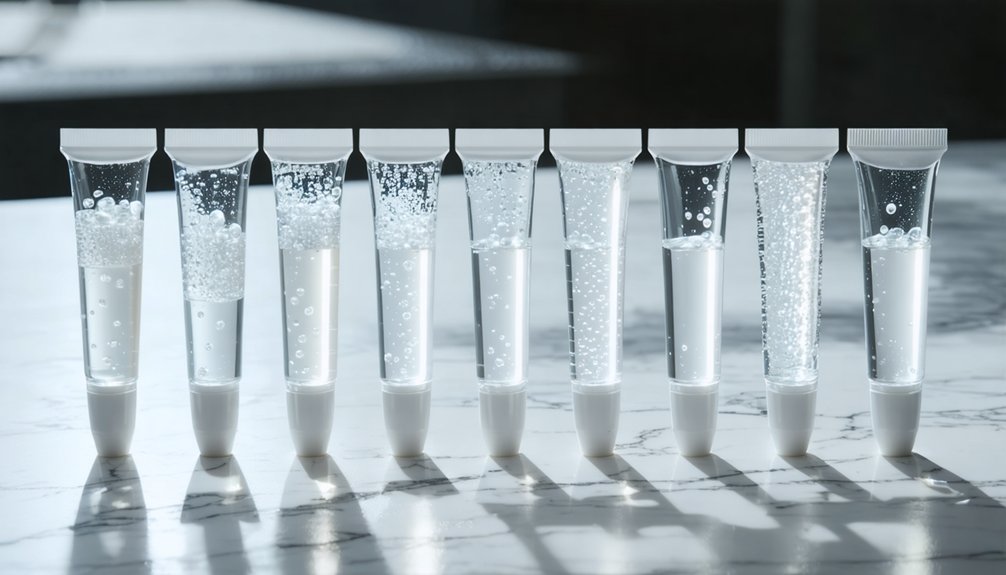
Understanding the cost implications of different teeth whitening options helps patients make informed decisions about their dental care investments.
Making smart choices about teeth whitening starts with understanding how different treatment costs impact your overall dental care budget.
When performing a cost comparison, you’ll find OTC products range from $10-$55, offering an accessible entry point for basic whitening needs. Professional take-home kits, while pricier at $200-$600, provide stronger formulations and custom-fitted trays.
In-office treatments command $300-$1,000, reflecting their higher concentration gels and immediate results.
Consumer preferences often balance between immediate results and budget constraints. While professional treatments deliver 3-8 shade improvements in one session, their higher upfront costs may seem intimidating.
However, considering the reduced need for repeated OTC purchases and more reliable outcomes, professional options can prove cost-effective in the long term, especially with available financing options.
Maintenance Strategies for Long-Lasting Results
The success of any teeth whitening treatment extends far beyond the initial procedure. To maintain your brilliant results, you’ll need to establish consistent maintenance habits and follow essential whitening tips from dental professionals.
These strategies will help protect your investment and guarantee long-lasting brightness.
- Schedule professional cleanings every six months to remove surface stains
- Use dentist-recommended whitening toothpaste and at-home touch-up trays
- Avoid dark-pigmented foods and beverages for two weeks post-treatment
- Incorporate crunchy fruits and vegetables that naturally clean teeth
- Store whitening products properly and follow application instructions carefully
Your dedication to proper oral hygiene practices, including twice-daily brushing and regular flossing, combined with smart dietary choices and professional care, will help preserve your whitening results.
Remember to use a straw when consuming staining beverages and maintain adequate hydration for peak oral health.
Professional Vs DIY Whitening Methods
When deciding between professional and DIY teeth whitening methods, patients must weigh several critical factors that influence both outcomes and oral health.
Professional consultations offer higher peroxide concentrations (25-40%) and protective measures, delivering dramatic results in just one session while safeguarding your gums and enamel.
Despite common whitening myths, DIY methods aren’t always more cost-effective, as they require extended use and may need multiple kit purchases.
While DIY whitening seems cheaper upfront, repeated kit purchases and longer treatment times can make professional options more economical overall.
While DIY options provide convenience with their $20-$50 price point, they typically contain lower peroxide levels (3-10%) and carry increased risks of uneven results or sensitivity.
You’ll achieve superior outcomes through professional treatment, especially if you have sensitive teeth or dental work, as dentists can customize procedures and monitor your progress while ensuring lasting, uniform results.
Frequently Asked Questions
Can I Whiten My Teeth While Wearing Braces or Dental Implants?
You shouldn’t whiten with braces as it’ll cause uneven results. While dental implants don’t respond to whitening treatments, you’ll need to wait until your braces are removed for consistent whitening outcomes.
How Soon After a Root Canal Can I Start Teeth Whitening?
You’ll need to wait 2-4 weeks post root canal before starting any whitening treatment. Consult your dentist first, as they’ll determine if your tooth has healed properly for safe whitening procedures.
Will Whitening Gels Affect the Color of Existing Dental Crowns?
Like throwing bleach on a ceramic mug, you won’t see any change in crown discoloration with whitening gels. Your crown’s material is non-porous, making gel effectiveness nonexistent on artificial surfaces.
Does Smoking Immediately After Whitening Treatment Reverse the Effects?
While smoking won’t instantly reverse your whitening results, it’ll considerably reduce whitening longevity. You’ll experience accelerated staining effects if you smoke immediately after treatment when your enamel is most vulnerable.
Can Pregnant or Nursing Mothers Safely Use Whitening Gels?
You shouldn’t use whitening gels while pregnant or nursing due to safety concerns and limited research. Instead, focus on gentle alternatives like proper brushing, avoiding staining foods, and using fluoride toothpaste.
References
- https://nhdentistrybeverlyhills.com/press/a-dentist-shares-5-at-home-teeth-whitening-products-actually-worth-buying/
- https://www.goodhousekeeping.com/health-products/g28723133/best-at-home-teeth-whitening-products/
- https://www.laserglowspa.com/blogs/news/top-professional-teeth-whitening-gels-ranked
- https://wewhiten.com/which-teeth-whitening-kit-is-the-best/
- https://www.rejuv-health.com/cosmetic-dentistry/teeth-whitening-cost/
- https://www.smilebrilliant.com/product/teeth-whitening-gel/
- https://www.cinoll.com/blog/teeth-whitening-gel-ingredients
- https://www.colgate.com/en-gb/oral-health/teeth-whitening/what-is-teeth-whitening-gel
- https://gloscience.com/blogs/blog/before-it-goes-in-your-mouth-check-your-ingredients
- https://pmc.ncbi.nlm.nih.gov/articles/PMC4058574/
